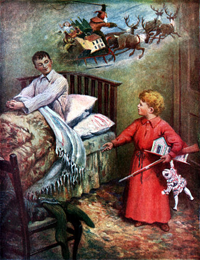 For parents, this time of year can feel like walking through a minefield, with ads, decorations and music all aimed at getting kids excited about Christmas. Every year children eagerly ask Santa for the “hottest,” “must-have” toys – and then turn that “pester power” on their parents.
For parents, this time of year can feel like walking through a minefield, with ads, decorations and music all aimed at getting kids excited about Christmas. Every year children eagerly ask Santa for the “hottest,” “must-have” toys – and then turn that “pester power” on their parents.
The term “pester power” is a technical one: it's how advertisers refer to the ability of children to influence their parents' spending, and it's a key part of their marketing strategies. With good reason: a 2002 YTV study found that children aged 9-14 influenced $20 billion dollars in family spending each year. And, of course, Christmas is key to that – in fact, it often makes up a fifth or more of retailers' total revenues. That means that advertisers spend a lot of time and money to try to get children using that pester power – not just on Santa.
Of course, few parents want to be Grinches -- we all want to make our children happy – but there can be a middle ground between giving in to pester power and canceling Christmas altogether. Here are some tips on how to control Christmas consumerism:
Have rules. Discuss holiday spending ahead of time; be clear and consistent about what things you are and aren't willing to buy and about situations where children are allowed to ask for things. For instance, you might say that Christmas requests made before December 1st will be ignored, or that no Christmas wishes can be made while in a store or while the TV is on. (My parents had a blanket rule against buying things that had been advertised on TV.) You may also want to have rules about the particular kinds of things you are and aren't willing to buy.
Don't negotiate. When children ask for something that you're not willing or able to buy them, don't be tempted to respond with a counter-offer: stick to the rules you've established. Keep the rules consistent for everyone in your family.
Limit exposure to advertising and brands. You can limit the number of commercials your children see on TV by recording the shows they like and then fast-forwarding through the commercials. Commercial-free channels, such as TVO and PBS, are good alternatives as well. It's harder to keep children from being exposed to brands, because almost all merchandise for children is branded and even shows on public television often have had brands built around them. While parents always have the option of refusing to buy (or accept) branded merchandise, a middle-ground is to only buy products where the brand is actually part of the content of the product – you might be willing to buy, for instance, Thomas the Tank Engine books or videos (which are about the character) or toy trains (which allow children to re-enact the stories in the books, or make up new ones) but not Thomas pyjamas. This can curb the desire to have every product that bears the brand.
Be aware of online advertising. Many parents are unaware of just how commercialized children's Internet spaces are. In fact, most of the sites most popular among kids either carry advertising or are directly associated with a brand (such as MyScene with Barbie and Millsberry with General Mills cereals.) If you're trying to limit your children's exposure to advertising and branding, being aware of what they're encountering online is an important step.
Discuss advertising with your kids. One of the concerns about advertising is that children aren't able to question the messages they receive, and sometimes can't even tell the difference between content and advertising. (This is particularly challenging in cases where the content and advertising are mixed together, as in the Web sites mentioned above.) Talk to your children early (and often – what children are able to understand about advertising changes as they get older) about what the purpose of advertising is and the various tricks that marketers use to make us want their products.
Keep Christmas fever under control. As Christmas approaches, kids get more and more excited about what they hope to find under the tree. During the weeks beforehand you can defuse that somewhat by going to places where they can get new things at little or no cost: regular visits to the library are good for this, as are thrift shops (these are a good opportunity to encourage children to give away some of their old or unused toys as well, though it's best not to tie getting a toy directly to giving one away.)
Related Resources
Talking to Kids About Advertising
